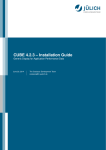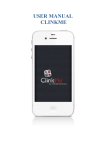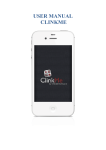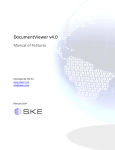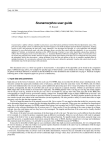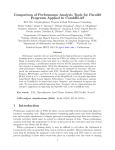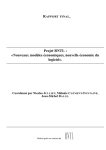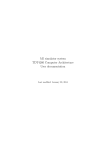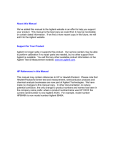Download Scalasca User Guide - Forschungszentrum Jülich
Transcript
CUBE 4.3.2 – Installation Guide Generic Display for Application Performance Data June 14, 2015 The Scalasca Development Team [email protected] ii Chapter 0. Copyright Copyright Copyright © 1998–2015 Forschungszentrum Jülich GmbH, Germany Copyright © 2009–2015 German Research School for Simulation Sciences GmbH, Jülich/Aachen, Germany All rights reserved. Redistribution and use in source and binary forms, with or without modification, are permitted provided that the following conditions are met: • Redistributions of source code must retain the above copyright notice, this list of conditions and the following disclaimer. • Redistributions in binary form must reproduce the above copyright notice, this list of conditions and the following disclaimer in the documentation and/or other materials provided with the distribution. • Neither the names of Forschungszentrum Jülich GmbH or German Research School for Simulation Sciences GmbH, Jülich/Aachen, nor the names of their contributors may be used to endorse or promote products derived from this software without specific prior written permission. THIS SOFTWARE IS PROVIDED BY THE COPYRIGHT HOLDERS AND CONTRIBUTORS "AS IS" AND ANY EXPRESS OR IMPLIED WARRANTIES, INCLUDING, BUT NOT LIMITED TO, THE IMPLIED WARRANTIES OF MERCHANTABILITY AND FITNESS FOR A PARTICULAR PURPOSE ARE DISCLAIMED. IN NO EVENT SHALL THE COPYRIGHT OWNER OR CONTRIBUTORS BE LIABLE FOR ANY DIRECT, INDIRECT, INCIDENTAL, SPECIAL, EXEMPLARY, OR CONSEQUENTIAL DAMAGES (INCLUDING, BUT NOT LIMITED TO, PROCUREMENT OF SUBSTITUTE GOODS OR SERVICES; LOSS OF USE, DATA, OR PROFITS; OR BUSINESS INTERRUPTION) HOWEVER CAUSED AND ON ANY THEORY OF LIABILITY, WHETHER IN CONTRACT, STRICT LIABILITY, OR TORT (INCLUDING NEGLIGENCE OR OTHERWISE) ARISING IN ANY WAY OUT OF THE USE OF THIS SOFTWARE, EVEN IF ADVISED OF THE POSSIBILITY OF SUCH DAMAGE. iii Chapter 0. Copyright iv Contents Contents Copyright 1 CUBE Installation Guide 1.1 1.2 1.3 1.4 1.5 1.6 2 iii Introduction . . . . . . Availability & License Prerequisites . . . . . . Installation . . . . . . Configuration . . . . . Support . . . . . . . . Bibliography 1 . . . . . . . . . . . . . . . . . . . . . . . . . . . . . . . . . . . . . . . . . . . . . . . . . . . . . . . . . . . . . . . . . . . . . . . . . . . . . . . . . . . . . . . . . . . . . . . . . . . . . . . . . . . . . . . . . . . . . . . . . . . . . . . . . . . . . . . . . . . . . . . . . . . . . . . . . . . . 1 1 2 2 6 6 7 v Chapter 1. CUBE Installation Guide 1 CUBE Installation Guide 1.1 Introduction CUBE (C UBE Uniform Behavioral Encoding) is a presentation component suitable for displaying a wide variety of performance data for parallel programs including MPI and OpenMP applications. CUBE allows interactive exploration of the performance data in a scalable fashion. Scalability is achieved in two ways: hierarchical decomposition of individual dimensions and aggregation across different dimensions. All metrics are uniformly accommodated in the same display and thus provide the ability to easily compare the effects of different kinds of program behavior. The CUBE package currently consists of five components: • A simple CUBE writer library written in C. • A simple CUBE reader library written in Java. • The full-featured C++ CUBE library for reading and writing CUBE files. • A set of command-line tools to explore and modify CUBE files. • A graphical user interface based on the Qt application framework. The remainder of this document describes the generic installation procedure for the different CUBE components (i.e., the C and C++ libraries, the command-line tools, as well as the graphical user interfaces). 1.2 Availability & License CUBE is available as a source-code distribution for UNIX or UNIX-like platforms. It can be downloaded from http://www.scalasca.org. Besides the standalone distribution, CUBE is also distributed as part of the Scalasca performance analysis toolset available via the same web page. The CUBE software is free, but by downloading, installing and using it you agree to comply with the license agreement. Please read the file LICENSE in the distribution’s top-level directory for precise wording. 1 Chapter 1. CUBE Installation Guide 1.3 Prerequisites Depending on the components of CUBE that are to be built, various tools and packages are required to be available on the build system. Common requirements---needed to build any of the components---are: • GNU make http://www.gnu.org/software/make/ • zlib (CUBE can be build without zlib support if zlib is not available) http://www.zlib.net/ Both are typically already installed on most systems. For zlib, you also need the development headers to be installed (might be provided by a separate package, e.g., on Linux systems). For the graphical user interface an additional library/framework is required: • Qt Framework (version 4.3 or higher) http://qt.nokia.com/ 1.4 Installation This section describes the general procedure to build and install the CUBE software. Before proceeding with the instructions given below, please make sure to also read the Qt installation notes in Appendix’qt_notes’as well as the platform- and compilerspecific notes in Appendix’platform’. To configure and install the CUBE package, the following steps are usually required: 1. Unpack the sources gunzip -c cube-4.x.x.tar.gz | tar xvf - 2. Change into the CUBE source code directory cd cube-4.x.x 3. Create a VPATH directory, where do you build the CUBE, and change into it mkdir -p vpath; cd vpath 4. Run the configure script ../configure The configure script tries to determine whether the requirements for building CUBE are fulfilled and sets up the build configuration. The configure script provides a set of various options. The full list is displayed when invoking: ../configure --help=recursive 2 1.4. Installation A list of main options: --prefix=dir Specifies the installation directory (default: /opt/cube ) --with-nocross-compiler-suite=(gcc|ibm|intel|pathscale|pgi|studio|open64|clang) The compiler suite to build this package in non cross-compiling environments with. Needs to be in $PATH [gcc]. --with-frontend-compiler-suite=(gcc|ibm|intel|pathscale|pgi|studio|open64|clang) The compiler suite to build the frontend parts of this package in crosscompiling environments with. Needs to be in $PATH [gcc]. --with-cubelib | --without-cubelib Enables (default) or disables building and installation of the cube c++ library. --with-tools | --without-tools Enables (default) or disables building and installation of cube tools. --with-gui | --without-gui Enables (default) or disables building and installation of the Cube GUI. --with-plugin-example | --without-plugin-example Enables (default) or disables building and installation of the Cube GUI plugin "Example". --with-cwriter | --without-cwriter Enables (default) or disables building and installation of the C cube writer. --with-java-reader | --without-java-reader Enables (default) or disables the compilation, build and installation of the cube java reader --with-xerces-path=path Specifies the path to the xerces.jar (default: /usr/share/java) --with-xerces-name= Name.jar Specifies the name of the jar file with the xerces xml parser (default: xerces.jar) --with-frontend-zlib="path to frontend zlib" Defines the zlib library, used by cube on frontend --with-backend-zlib="path to backend zlib" Defines the zlib library, used by cube on backend --with-compression=full|ro|none Enables or disables zlib compression support in cube: full All parts of the framework create compressed cubes and read com- pressed and uncompressed cube files. ro Read only configuration. Created cube files are uncompressed, but tools and GUI can open and operate with compressed cube files. This is default value. none Zlib library is not used in this case and compressed cube files are not 3 Chapter 1. CUBE Installation Guide supported. --with-qt=path Forces to look for Qt in the path in first place. If this option is omitted the configure script searches for a Qt installation using the following sequence: a) $QT_DIR b) $PATH c) /usr/local/Trolltech/ d) /opt/local/libexec/qt4-mac/ (to support Mac) e) /opt/lib/qt4 f) /usr/lib/qt/bin g) /usr/lib32/qt4 h) /usr/lib32/qt i) /usr/lib64/qt4 j) /usr/lib64/qt k) /opt/qt l) /opt/qt4 m) /usr/local/qt4 n) /usr/local/qt --with-qt-specs=spec Defines a specs for Qt (Default is "default") --with-vampir | --without-vampir Enables (default) or disables support of TraceBrowser connection with Vampir. The support of TraceBrowser is only possible if DBUS headers and DBUS library are available. The configure script tries to find them automatically. If it fails, you have to specify the exact place of two headers: dbus/dbus.h and dbus/dbus-arch-deps.h. You can do it like ../configure --prefix=/opt/software/cube \ CPPFLAGS=’-I/usr/include/dbus-1.0 \ -I/usr/lib64/dbus-1.0/include’" --with-paraver | --without-paraver Enables Browser connection with Paraver. support of Trace- See the note above. --with-paraver-cfg=FILE Uses FILE as a configuration file for Paraver. --with-buffersize=N Use N bytes buffer for I/O operations (default N=1Mb) --disable-shared Disables building of a shared CUBE C++ library. (Build 4 1.4. Installation with shater libraries is supported only for some compilers/platforms) --with-strategy=keepall|preload|manual|lastn Selects a default data loading strategy. a) keepall - data is loaded on demand and kept in memory to the end of lyfecycle of the Cube object. b) preload - all data is loaded during the metric initialization and kept in memory to the end of lyfecycle of the Cube object. c) manual - Application should request and drop the data sets explicitly. No correctness check is performed. Therefore one has to use this strategy with care. d) lastn - Only N last used data rows are kept in memory. N is specified via command line option --with-nrows=N The configure script assumes that the GNU C/C++ compilers should be used to compile CUBE. You can select a different compiler using one of the options above e.g. ../configure - -with-nocross-compiler-suite=intel If you want to use alternative compilers or compiler optimization options, which are not listed in the description of the options, you can do so by specifying appropriate variables in the command line when invoking configure, e.g., ../configure --prefix=/opt/software/cube CC=xlc CFLAGS="-g -O2" For a list of the recognized variables, please inspect the output of the command ./configure - -help=recursive 5. Start the build process make or make -j N 6. You can invoke a test suite of the CUBE framework make check If all tests pass, everything looks good. If some tests do not pass, please report it to [email protected] and attach the file configure.log 7. Install the software make install 5 Chapter 1. CUBE Installation Guide 1.5 Configuration CUBE provides the option of displaying an online description for entries in the metric tree via a context menu. By default, it will search for the given HTML description file on all the mirror URLs specified in the CUBE file. In case there is no Internet connection, the Qt-based CUBE GUI can be configured to also search in a list of local directories for documentation files. These additional search paths can be specified via the environment variable CUBE_DOCPATH as a colon-separated list of local directories, e.g., CUBE_DOCPATH=/opt/software/doc:/usr/local/share/doc Note that this feature is only available in the Qt-based GUI and not in the older wxWidgets-based one. To prevent CUBE from trying to load the HTML documentation via HTTP or HTTPS mirror URLs (e.g., in restricted environments were outbound connections are blocked by a firewall and the timeout is taking very long), the environment variable CUBE_DISABLE_HTTP_DOCS can be set to either 1, yes or true. To prevent CUBE from trying to load the HTML documentation via HTTP or HTTPS mirror URLs (e.g., in restricted environments were outbound connections are blocked by a firewall and the timeout is taking very long), the environment variable CUBE_DISABLE_HTTP_DOCS can be set to either 1, yes or true. CUBE C++ library allows to control the way it loads the data using the environment variable CUBE_DATA_LOADING. Following values are possible: 1. keepall - data is loaded on demand and kept in memory to the end of lyfecycle of the Cube object. 2. preload - all data is loaded during the metric initialization and kept in memory to the end of lyfecycle of the Cube object. 3. manual - Application should request and drop the data sets explicitly. No correctness check is performed. Therefore one has to use this strategy with care. 4. lastn - Only N last used data rows are kept in memory. N is specified via environment variable CUBE_NUMBER_ROWS 1.6 Support If you have any questions or comments you would like to share with the CUBE developers, please send an e-mail to [email protected]. 6 Chapter 2. Bibliography 2 Bibliography Message Passing Interface Forum: MPI: A Message Passing Interface Standard — Version 2.2, September, 2009, http://www.mpi-forum.org OpenMP Architecture Review Board: OpenMP Fortran Application Program Interface — Version 3.0, May, 2008, http://www.openmp.org 7













